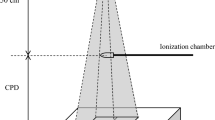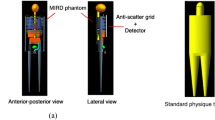Abstract
Previous radiation protection-measure studies for medical staff who perform X-ray fluoroscopy have employed simulations to investigate the use of protective plates and their shielding effectiveness. Incorporating directional information enables users to gain a clearer understanding of how to position protective plates effectively. Therefore, in this study, we propose the visualization of the directional vectors of scattered rays. X-ray fluoroscopy was performed; the particle and heavy-ion transport code system was used in Monte Carlo simulations to reproduce the behavior of scattered rays in an X-ray room by reproducing a C-arm X-ray fluoroscopy system. Using the calculated results of the scattered-ray behavior, the vectors of photons scattered from the phantom were visualized in three dimensions. A model of the physician was placed on the directional vectors and dose distribution maps to confirm the direction of the scattered rays toward the physician when the protective plate was in place. Simulation accuracy was confirmed by measuring the ambient dose equivalent and comparing the measured and calculated values (agreed within 10%). The directional vectors of the scattered rays radiated outward from the phantom, confirming a large amount of backscatter radiation. The use of a protective plate between the patient and the physician’s head part increased the shielding effect, thereby enhancing radiation protection for the physicians compared to cases without the protective plate. The use of directional vectors and the surrounding dose-equivalent distribution of this method can elucidate the appropriate use of radiation protection plates.







Similar content being viewed by others
References
Miller DL. Make radiation protection a habit. Tech Vasc Interv Radiol. 2018;21(1):37–42. https://doi.org/10.1053/j.tvir.2017.12.008.
ICRP. Radiological protection in fluoroscopically guided procedures outside the imaging department. ICRP publication 117. Ann ICRP. 2010;40(6):1–102.
Abdelrahman M, Lombardo P, Camp A, et al. A parametric study of occupational radiation dose in interventional radiology by monte-carlo simulations. Phys Med. 2020;78:58–70. https://doi.org/10.1016/j.ejmp.2020.08.016.
Miller DL. Overview of contemporary interventional fluoroscopy procedures. Health Phys. 2008;95(5):638–44. https://doi.org/10.1097/01.HP.0000326341.86359.0b.
Vano E, Gonzalez L, Fernández JM, Haskal ZJ. Eye lens exposure to radiation in interventional suites: caution is warranted. Radiology. 2008;248(3):945–53.
Kim KP, Miller DL, Balter S, et al. Occupational radiation doses to operators performing cardiac catheterization procedures. Health Phys. 2008;94(3):211–27. https://doi.org/10.1097/01.HP.0000290614.76386.35.
Haga Y, Chida K, Kimura Y, et al. Radiation eye dose to medical staff during respiratory endoscopy under X-ray fluoroscopy. J Radiat Res. 2020;61(5):691–6. https://doi.org/10.1093/jrr/rraa034.
Busoni S, Bruzzi M, Giomi S, et al. Surgeon eye lens dose monitoring in interventional neuroradiology, cardiovascular, and radiology procedures. Phys Med. 2022;104:123–8. https://doi.org/10.1016/j.ejmp.2022.11.002.
Morcillo AB, Alejo L, Huerga C, et al. Occupational doses to the eye lens in pediatric and adult noncardiac interventional radiology procedures. Med Phys. 2021;48(4):1956–66. https://doi.org/10.1002/mp.14753.
Samara ET, Cester D, Furlan M, Pfammatter T, Frauenfelder T, Stüssi A. Efficiency evaluation of leaded glasses and visors for eye lens dose reduction during fluoroscopy guided interventional procedures. Phys Med. 2022;100:129–34. https://doi.org/10.1016/j.ejmp.2022.06.021.
García Balcaza V, Camp A, Badal A, et al. Fast monte carlo codes for occupational dosimetry in interventional radiology. Phys Med. 2021;85:166–74. https://doi.org/10.1016/j.ejmp.2021.05.012.
ICRP. Occupational radiological protection in interventional procedures ICRP publication 139. Ann ICRP. 2018;47(2):1–118.
Meisinger QC, Stahl CM, Andre MP, Kinney TB, Newton IG. Radiation protection for the fluoroscopy operator and staff. Am J Roentgenol. 2016;207(4):745–54. https://doi.org/10.2214/AJR.16.16556.
Santos WS, Belinato W, Perini AP, et al. Occupational exposures during abdominal fluoroscopically guided interventional procedures for different patient sizes—a Monte Carlo approach. Phys Med. 2018;45:35–43. https://doi.org/10.1016/j.ejmp.2017.11.016.
Hirata Y, Fujibuchi T, Fujita K, et al. Angular dependence of shielding effect of radiation protective eyewear for radiation protection of crystalline lens. Radiol Phys Technol. 2019;12(4):401–8. https://doi.org/10.1007/s12194-019-00538-2.
Chida K. What are useful methods to reduce occupational radiation exposure among radiological medical workers, especially for interventional radiology personnel? Radiol Phys Technol. 2022;15(2):101–15. https://doi.org/10.1007/s12194-022-00660-8.
van Rooijen BD, de Haan MW, Das M, et al. Efficacy of radiation safety glasses in interventional radiology. Cardiovasc Intervent Radiol. 2014;37(5):1149–55. https://doi.org/10.1007/s00270-013-0766-0.
Mao L, Liu T, Caracappa PF, et al. Infuences of operator head posture and protective eyewear on eye lens doses in interventional radiology: a mont carlo study. Med Phys. 2019;46(6):2744–51. https://doi.org/10.1002/mp.13528.
Yanagawa A, Takata T, Onimaru T, et al. New perforated radiation shield for anesthesiologists: monte carlo simulation of effects. J Radiat Res. 2023;64(2):379–86. https://doi.org/10.1093/jrr/rrac106.
Eder H, Seidenbusch MC, Treitl M, Gilligan P. A new design of a lead-acrylic shield for staff dose reduction in radial and femoral access coronary catheterization. Rofo. 2015;187(10):915–23. https://doi.org/10.1055/s-0034-1399688.
Nishi K, Fujibuchi T, Yoshinaga T. Development and evaluation of the effectiveness of educational material for radiological protection that uses augmented reality and virtual reality to visualize the behavior of scattered radiation. J Radiol Prot. 2022;42(1):011506. https://doi.org/10.1088/1361-6498/ac3e0a.
Nishi K, Fujibuchi T, Yoshinaga T. Development of an application to visualise the spread of scattered radiation in radiography using augmented reality. J Radiol Prot. 2020;40(4):1299–310. https://doi.org/10.1088/1361-6498/abc14b.
Fujibuchi T. Radiation protection education using virtual reality by visualization of scatter distribution in radiological examination. J Radiol Prot. 2021;41(4):S317–28. https://doi.org/10.1088/1361-6498/ac16b1.
Sato N, Fujibuchi T, Toyoda T, et al. Consideration of the protection curtain’s shielding ability after identifying the source of scattered radiation in the angiography. Radiat Prot Dosim. 2017;175(2):238–45. https://doi.org/10.1093/rpd/ncw291.
Sato T, Iwamoto Y, Hashimoto S, et al. Features of particle and heavy ion transport code system (PHITS) version 3.02. J Nucl Sci Technol. 2018;55:684–90. https://doi.org/10.1080/00223131.2017.1419890.
Ishii H, Satsurai K, Uesugi N, et al. Fundamental characteristics of a semiconductor survey meter. J Rad Safe Man. 2018;17(1):2–8. https://doi.org/10.11269/jjrsm.17.2.
Satsurai K, Ishii H, Haga Y, et al. Performance evaluation of new survey meter capable of the energy measurement in diagnostic radiology. J Rad Safe Man. 2018;17(2):114–20. https://doi.org/10.11269/jjrsm.17.114.
Kato H. X-ray, electron beam, beta-ray spectrum, Laboratory of Radiological Technology, https://hidekikato1952.wixsite.com/radiotechnology/soft-2; Accessed 13 Dec 2022.
ICRP. Conversion coefficients for use in radiological protection against external radiation. ICRP publication 74. Ann ICRP. 1996;26(3–4):5–19.
ICRP. Adult reference computational phantoms ICRP publication 110. Ann ICRP. 2009;39(2):1.
Paraview. https://www.paraview.org/. Accessed 13 Dec 2022.
International Electrotechnical Commission, Radiation protection instrumentation—Ambient and/or directional dose equivalent (rate) meters and/or monitors for beta, X and gamma radiation—Part 1: Portable workplace and environmental meters and monitors. IEC 60846–1: 2009, International Electrotechnical Commission, 2009.
O’Connor U, Walsh C, Gorman D, et al. Feasibility study of computational occupational dosimetry: evaluating a proof-of-concept in an endovascular and interventional cardiology setting. J Radiol Prot. 2022;42(4):041501. https://doi.org/10.1088/1361-6498/ac9394.
Funding
This study was supported in part by an Industrial Disease Clinical Research grant (220201-01) from Japan.
Author information
Authors and Affiliations
Corresponding author
Ethics declarations
Conflict of interests
The authors declare that they have no known competing financial interests or personal relationships that could have appeared to influence the work reported in this paper.
Additional information
Publisher's Note
Springer Nature remains neutral with regard to jurisdictional claims in published maps and institutional affiliations.
About this article
Cite this article
Hizukuri, K., Fujibuchi, T. & Arakawa, H. Directional vector visualization of scattered rays in mobile c-arm fluoroscopy. Radiol Phys Technol 17, 288–296 (2024). https://doi.org/10.1007/s12194-024-00779-w
Received:
Revised:
Accepted:
Published:
Issue Date:
DOI: https://doi.org/10.1007/s12194-024-00779-w




